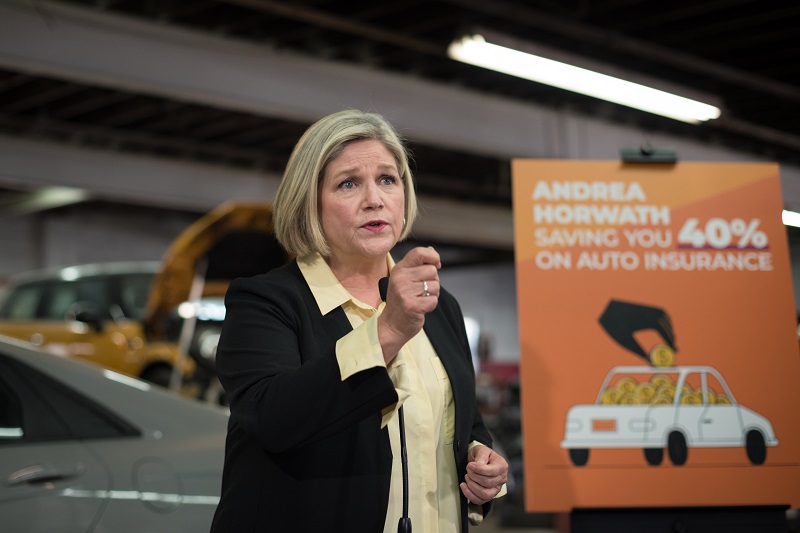
NDP auto platform: 40% rate cut, frozen rate increases, and a Fair Pricing Commission
May 11, 2022 by Jason Contant

Print this page Share
Ontario NDP Leader Andrea Horwath has proposed to lower auto insurance rates by 40% and investigate a “new system” for auto insurance that could include a public or partially public system.
Horwath says if she is elected premier in the upcoming provincial election on June 2, she will lower rates 40% by “fixing the auto insurance industry.” To do this, she’ll end the practice of using different insurance rates based on customers’ postal codes (where places like Brampton can see higher rates than other parts of the province).
Horwath will also ban auto insurance rate increases for 18 months “while an expert commission investigates and recommends a new system — a public or partially public system, or major reforms to the private system,” the Ontario NDP says in a press release Wednesday.
Insurance Bureau of Canada (IBC) tells Canadian Underwriter that “today’s announcement by the NDP will not result in savings for drivers.
“Proposals to freeze auto insurance rates and end the use of territory as a rating factor do little to address the underlying cost pressures in the current system,” IBC says. “Instead, these proposals would result in drivers across the province being unfairly penalized, and forced to subsidize the cost for high risk drivers in other regions.”
As well, a move to a government-run auto insurance system would “place an enormous burden on taxpayers – whether they drive or not – with billions of dollars in new costs,” IBC says. “That includes establishing a new government bureaucracy. That means less money to invest in hospitals and schools. Government-run no-fault insurance systems typically also remove the right of people injured in accidents to sue for the care and support they need to recover.”
Part of the NDP platform is to immediately strike the Ontario Auto Insurance Fair Pricing Commission, led by insurance experts, affordability advocates, and experts in public auto from provinces that use such a system. The commission will be directed to explore:
- A full public no-fault auto insurance system like in Manitoba, Saskatchewan and British Columbia
- Quebec’s hybrid public-private model (where the government pays compensation for bodily injuries, while private insurers handle vehicle damage)
- A private no-fault system
- Specific reforms in legislation leading to permanent rate reductions.
“Let’s stop paying more for auto insurance just because of where we live,” Horwath says in the release. “The auto insurance system is broken, and together we can fix it — and put $660 a year [on average] in people’s pockets. In some communities, like Brampton, the savings will be upwards of $2,000.”
It’s not clear how the Ontario NDP calculated the average savings. Rate comparison site Ratesdotca says the average premium across Ontario in 2021 was $1,555, and $1,976 in Brampton. However, last year, rates fell in Brampton by nearly 27% due to pandemic-related lower claims activity.
“Ontario has some of the most expensive auto insurance premiums in the country, despite some of the lowest rates of auto accidents,” the NDP says. “Postal code discrimination means that drivers in many neighbourhoods pay dramatically higher rates than drivers anywhere else, even if they have the same age, experience, car and driving record.”
IBC says the association and its members have encouraged governments since the early 1990s to fix the defects in Ontario’s government-regulated auto insurance system that are placing economic hardship on drivers in the province.
By contrast, drivers in the public auto jurisdictions of B.C., Saskatchewan and Manitoba pay much less in premiums than their Ontario counterparts, the NDP notes.
In Alberta, the previous NDP government capped auto rates hikes at 5% in 2017, but it meant insurers couldn’t raise rates to keep up with escalating auto claims costs. When it came to power in 2019, the United Conservative Party eliminated the rate cap.
Feature image: NDP Leader Andrea Horwath answers questions from the media, after announcing their plan to lower auto insurance rates by 40 per cent if elected, during a campaign stop in Brampton, Ont., Wednesday, May 11, 2022. THE CANADIAN PRESS/ Tijana Martin